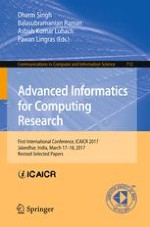2017 | Book
Advanced Informatics for Computing Research
First International Conference, ICAICR 2017, Jalandhar, India, March 17–18, 2017, Revised Selected Papers
Editors: Dharm Singh, Balasubramanian Raman, Ashish Kumar Luhach, Pawan Lingras
Publisher: Springer Singapore
Book Series : Communications in Computer and Information Science
